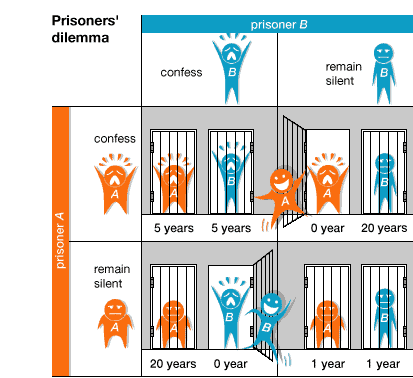Originally posted on November 4, 2018 @ 11:26 pm
Game Theory 101: The Prisoner’s Dilemma & Iterated Prisoner’s Dilemma Game Simulation
The Prisoner’s Dilemma, a fundamental concept in game theory, reveals insights into the balance between cooperation and competition. Its basic premise involves two prisoners who must choose between cooperating with each other or betraying the other.
While each prisoner’s decision comes with its own set of consequences, the dilemma illustrates the complexity of decision-making processes and the potential for suboptimal outcomes—even when individuals try to act in their own self-interest.
Expanding on this concept, the Iterated Prisoner’s Dilemma takes on additional complexity by simulating repeated interactions between the same players. This allows for a richer understanding of strategic behavior over time, where the shadow of the future can influence current decisions. It provides a framework through which we can examine real-world issues like price competition, collusion, and the emergence of cooperation within competitive environments.
Key Takeaways
- The Prisoner’s Dilemma demonstrates the conflict between self-interest and collective benefit.
- Repeated games in the Iterated Prisoner’s Dilemma introduce the potential for strategy and reciprocity.
- Understanding these models can shed light on the dynamics of competition and cooperation in economic markets.
Classical Prisoner’s Dilemma Game Simulation
In the Classical Prisoner’s Dilemma, your strategic choices can lead to various outcomes.
When faced with the decision to remain silent or confess, you’re confronted with multiple scenarios involving jail time, payoff, and punishment.
- If you and your accomplice both remain silent:
- Jail Time: 1 year each
- Reward: Mutual trust preserved
- If you confess:
- Jail Time: 0 years for you, 20 years for them
- Temptation: Immediate freedom, high cost to accomplice
- If your accomplice confesses:
- Jail Time: 20 years for you, 0 years for them
- Punishment: Maximum time due to betrayal
- If both confess:
- Jail Time: 5 years each
- Payoff: Equal punishment, but more than if both had remained silent
In repeated simulations of the dilemma, your decisions build on each other, letting you potentially cultivate a strategy over time.
Mutual cooperation or betrayal in these simulations can mirror the complexity of real-life social interactions, like the reciprocal altruism observed in animal behaviors such as mutual grooming.
Choose wisely, as each move could significantly alter your and your accomplice’s fate.

What is The Prisoner’s Dilemma?
The Prisoner’s Dilemma is a fundamental problem in game theory that exhibits why two completely rational individuals might not cooperate, even if it appears that it is in their best interests to do so. In its classic form, you and another prisoner are faced with a choice without the ability to communicate: either betray the other by confessing to the crime or cooperate by remaining silent.
Here’s a simplified overview of the outcomes based on your decision and the decision of your partner:
| Your Choice / Their Choice | Cooperate | Defect |
|---|---|---|
| Cooperate | -1, -1 | -20, 0 |
| Defect | 0, -20 | -5, -5 |
- If both prisoners choose to cooperate (stay silent), each serves 1 year in prison.
- If one decides to defect (betray) and the other cooperates, the defector goes free and the cooperator receives a 20-year sentence.
- If both choose to defect, each receives a 5-year sentence.
In a single interaction, rationality leads you to defect because it is the strategy that minimizes the maximum penalty; this is despite the fact that mutual cooperation yields a better outcome overall.
The dilemma arises because the decision to cooperate, while mutually beneficial, is overshadowed by the fear of being betrayed.

Practical implications in everyday life:
- In businesses and market competition scenarios, companies might face situations akin to the Prisoner’s Dilemma.
- Deciding between competitive pricing or market-sharing agreements parallels the cooperate or defect strategies.
- Social interactions often involve decisions that can be seen through the lens of the Prisoner’s Dilemma, for instance, group projects where individual contributions may vary significantly.
The Iterated Prisoner’s Dilemma:
When the game is repeated multiple times, participants have the chance to form strategies based on their partner’s past actions, which can encourage cooperation.
It reflects real-world social dynamics where people often encounter the same individuals repeatedly, thereby fostering an environment for mutual cooperation over time.

Complexities Beyond the Basic Game:
- Communication is generally prohibited, making trust and collaboration difficult to achieve.
- Snitching could lead to a more favorable individual outcome, creating a tempting defection scenario.
- In real-world situations with a reliable legal system, cooperation could be the most rational strategy as the risk of defection might carry more severe consequences.
Iterated Prisoner’s Dilemma Applications in the Market
Monopolistic Competition Explanation:

Strategies:
- Cooperate vs. Defect
- Trust building essential
- Tit-for-tat effectiveness
Game Outcomes:
| Cooperation | Defection |
|---|---|
| Mutual gain | Short-term advantage |
| Long-term relationships | Potential isolation |
Repeated Interactions:
- Encourages cooperation
- Reduces defection incentives
Price Competition, Collusion, Cartels, & Adam Smith

In a market dynamic explained by Adam Smith, your pursuit of self-interest may lead to price wars, where cutting costs to outdo competitors can harm collective revenue in the long run.
The tragedy of the commons is a risk, as everyone looking out for themselves can deplete shared resources.
- Self-Interest: Can drive aggressive price competition
- Economy: May become less profitable for all players
- Risk: A few firms dominate, often leading to potential collusion
- Collective Action: Necessary to avoid a race to the bottom
When you lower your prices, competitors may follow, eroding profits industry-wide.
As the market becomes more concentrated, the remaining players might form a cartel to control prices and reduce the competitiveness. Merger and acquisition strategies often lead to even greater market control, where companies can exert significant influence over the market to optimize value capture.
Background to the Evolution of Cooperation
Social Behavior
Animals living in groups have evolved a variety of social behaviors that enhance their survival.
Cooperative actions, such as hunting in packs or mounting a collective defense against predators, are manifestations of social behavior that can be explained by the biology of cooperation. In such scenarios, an individual may act to benefit another at a personal cost, a phenomenon often referred to as “altruism.”
Contrary to a strict interpretation of Darwinian natural selection, which emphasizes selfish attributes for survival, altruism within a group can in fact bolster the group’s overall fitness. This suggests a nuanced understanding of evolution wherein group selection can influence behaviors, fostering cooperation that benefits the collective.
| Social Behavior | Impact on Survival |
|---|---|
| Cooperative hunting | Increases efficiency and success rates |
| Altruistic defense | Enhances group protection |
| Group living | Reduces pressures of natural selection on individuals |

Reciprocity
Reciprocity is central in explaining cooperative behavior between unrelated individuals. It posits a system of give-and-take, where acts of altruism are performed with the expectation of future reciprocation.
Your benevolence towards others, even if they are not of your kin or species, can lead to a network of mutually beneficial interactions.
Such reciprocal relationships form the basis of many conflict and cooperation dynamics in nature. They are essential components of non-zero-sum games, where all participants can potentially benefit. This is opposed to zero-sum interactions, like predator-prey dynamics, where one entity’s gain is another’s loss.
Understanding and engaging in reciprocal behaviors contribute to a shared and expanded success, a principle that is evident in both natural ecosystems and human societies.
Engaging with competitors in a constructive manner, such as setting beneficial prices, can create a non-zero-sum situation, growing the market for everyone involved. Conversely, market dominance at the expense of competitors represents a zero-sum game.


